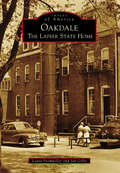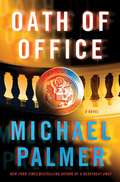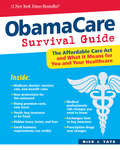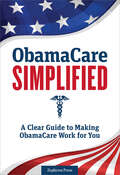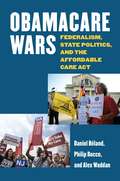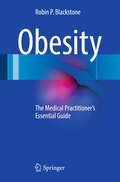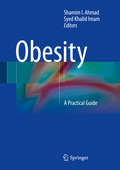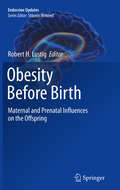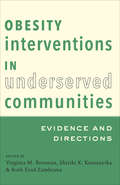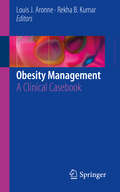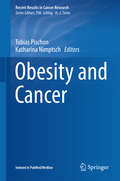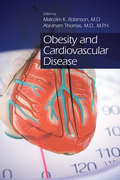- Table View
- List View
OTA-Lehrbuch: Ausbildung zur Operationstechnischen Assistenz
by Margret Liehn Heike Richter Leonid KasakovDer Beruf der OTA ist vielseitig, interessant und abwechslungsreich. Dieses Lehrbuch begleitet die Auszubildenden in ihrer dreijährigen Ausbildung und richtet sich nach der aktuellen Ausbildungs- und Prüfungsverordnung und dem aktuellen Anästhesietechnischen und Operationstechnischen Assistentengesetz (ATA-OTA-G) vom 14. Dezember 2019: Jedem Kapitel sind die jeweiligen Kompetenzschwerpunkte vorangestellt.Systematisch finden sich alle Aufgabenbereiche der Ausbildung wie Hygiene, Instrumentanz, Qualitätsmangement, die unterschiedlichen Einsatzorte wie Notaufnahme, Endoskopie und AEMP sowie die notwendigen gesetzlichen Grundlagen. Fallbeispiele, Merksätze und Praxistipps erleichtern das Lernen, zahlreiche Abbildungen und Grafiken veranschaulichen Zusammenhänge, eine Zusammenfassung am Ende des Kapitels und Fragen helfen das Gelernte zu überprüfen.Neu in der 3. Auflage: kurzer Überblick der Anatomie zu allen chirurgischen Themen, Zusammenfassungen nach jedem Themengebiet, Definitionen spezieller Begriffe sowie aktuelle Themen. Ideal für ein Lernen ohne medizinische und pflegerische Vorkenntnisse: Für Auszubildende zum täglichen Gebrauch und erfolgreichen Lernen, für Lehrende und Dozenten die ideale Vorbereitung auf den Unterricht! Empfohlen vom Deutschen OTA-Schulträgerverband.
OZONE
by Velio BocciOxygen-Ozone therapy is a complementary approach less known than homeopathy and acupuncture because it has come of age only three decades ago. This book clarifies that, in the often nebulous field of natural medicine, the biological bases of ozone therapy are totally in line with classical biochemistry, physiological and pharmacological knowledge. Ozone is an oxidizing molecule, a sort of super active oxygen, which, by reacting with blood components generates a number of chemical messengers responsible for activating crucial biological functions such as oxygen delivery, immune activation, release of hormones and induction of antioxidant enzymes, which is an exceptional property for correcting the chronic oxidative stress present in atherosclerosis, diabetes and cancer. Moreover, by inducing nitric oxide synthase, ozone therapy may mobilize endogenous stem cells, which will promote regeneration of ischemic tissues. The description of these phenomena offers the first comprehensive picture for understanding how ozone works and why. When properly used as a real drug within therapeutic range, ozone therapy does not only does not procure adverse effects but yields a feeling of wellness. Half the book describes the value of ozone treatment in several diseases, particularly cutanious infection and vascular diseases where ozone really behaves as a "wonder drug". The book has been written for clinical researchers, physicians and ozone therapists, but also for the layman or the patient interested in this therapy.
OZONE: A new medical drug
by Velio BocciOxygen-Ozone therapy is a complementary approach less known than homeopathy and acupuncture because it has come of age only three decades ago. This book clarifies that, in the often nebulous field of natural medicine, the biological bases of ozone therapy are totally in line with classical biochemistry, physiological and pharmacological knowledge. Ozone is an oxidizing molecule, a sort of super active oxygen, which, by reacting with blood components generates a number of chemical messengers responsible for activating crucial biological functions such as oxygen delivery, immune activation, release of hormones and induction of antioxidant enzymes, which is an exceptional property for correcting the chronic oxidative stress present in atherosclerosis, diabetes and cancer. Moreover, by inducing nitric oxide synthase, ozone therapy may mobilize endogenous stem cells, which will promote regeneration of ischemic tissues. The description of these phenomena offers the first comprehensive picture for understanding how ozone works and why. When properly used as a real drug within therapeutic range, ozone therapy does not only does not procure adverse effects but yields a feeling of wellness. Half the book describes the value of ozone treatment in several diseases, particularly cutanious infection and vascular diseases where ozone really behaves as a “wonder drug”. The book has been written for clinical researchers, physicians and ozone therapists, but also for the layman or the patient interested in this therapy.
Oakdale: The Lapeer State Home
by Jan Gillis Laura FromwillerThe Lapeer State Home has been a large part of the history of Lapeer County since its beginnings in 1895. After starting with three buildings and housing for 200 patients, the facility grew to encompass several hundred acres and, at its peak, accommodating over 4,000 patients. The history of the home includes a variety of memories from staff members, patients, and visitors who once walked its halls. Images of America: Oakdale: The Lapeer State Home provides a journey of this historic institution and attempts to bring some clarity to questions that remain about the home and its past.
Oath Of Office
by Michael PalmerTo protect. To defend. To obey. Doctors, police, and even the President of the United States swear an inviolate oath to their offices. Inviolate, that is, until it is broken. DR. JOHN MEACHAM goes on a shooting spree at his office, killing his associate, staff, and two patients. Then Meacham turns the gun on himself. Much of the blame for the massacre falls on Dr. Lou Welcome, who counseled Meacham years before when Meacham's medical license was suspended for problems related to his alcoholism and anger-management issues. Lou knew that Meacham was an excellent physician who'd shown a strong recovery, and fought hard for his license to be restored. After hearing the news of the shootings, Lou is stunned like everyone else, but he is also utterly incredulous. And when he begins to look into matters, the terrifying evidence he finds takes him down a path of unspeakable conspiracy that seems to lead directly to the White House. Shocking, chilling, and with scientific details that are based on today's headlines, Oath of Office will have you questioning everything you know about those entrusted with our health and our lives.
ObamaCare Survival Guide
by Nick J. TateWhen President Barack Obama signed the Patient Protection and Affordable Care Act, he handed Americans one of the most sweeping pieces of social legislation in U.S. history. Now that the Supreme Court has upheld ObamaCare, it is imperative that the American people understand the overwhelming impact it will have on their lives. The Affordable Care Act totals more than 2,700 pages and comprises nearly 500 provisions. For the first time, Humanix Books provides an easy-to-read guide to the law and its implications for every American. The ObamaCare Survival Guide: The Affordable Care Act and What It Means for You and Your Healthcare is the first guide book to help Americans understand the intricacies of ObamaCare. It serves as a valuable resource for those currently insured, those who are not, and the tens of millions of seniors, youth, business people and others who will be affected by the new law. About the Author: Nicholas J. Tate is an award-winning journalist and editor who has written extensively about health and consumer affairs issues. After a fellowship at the Harvard School of Public Health, he authored â œThe Sick Building Syndrome.â His work has also appeared in the Miami Herald, Sun Sentinel, Atlanta Journal-Constitution, Boston Herald, Newsmax and other publications.
Obamacare Simplified: A Clear Guide to Making Obamacare Work for You
by Zephyros PressObamaCare is a complex law that will affect every single American. Everyone has an opinion about ObamaCare, but few people actually understand how the Affordable Care Act works. ObamaCare Simplified navigates you through the intricacies of the health care law and explains what it means for you. Whether you are satisfied with your present insurance or seeking to get insured, ObamaCare Simplified informs you of your rights, presents the facts, and will help you make well-informed decisions when it comes to your health care plan. ObamaCare Simplified provides an easy-to-follow guide to the Affordable Care Act and what you need to know, offering: An overview of the goals and structure of ObamaCare, and how it changes the current health care system A "how it works" section that explains the individual mandate, insurance exchanges, and ObamaCare funding An ObamaCare timeline that provides a year-by-year breakdown of the law's implementation and what you need to know Spotlights on "what ObamaCare means for you," which explore the different impact of the law on various groups, including: senior citizens, immigrants, small-business employers, employees, uninsured individuals, and more Information on how ObamaCare affects individuals, depending on age, income, and employment status Taking care of your health should be your most vital priority. ObamaCare Simplified is your complete guide to understanding how ObamaCare works and what it means for your health care.
Obamacare Wars: Federalism, State Politics, and the Affordable Care Act (Studies in Government and Public Policy)
by Daniel Beland Philip Rocco Alex WaddanObamacare Wars shows how the law’s intergovernmental structure, which entails the participation of both the federal government and the states, has deeply shaped the politics of implementation. Focusing on the creation of insurance exchanges, the expansion of Medicaid, and execution of regulatory reforms, Daniel Béland, Philip Rocco, and Alex Waddan examine how opponents of the ACA fought back against its implementation.
Obesity
by Robin P. BlackstoneThis text translates the newest and latest science and research about obesity in an effort to change the mindset and educate all medical practitioners who see and treat any obese patient for any reason. This textbook will also be an invaluable, easy-to-use reference manual for any practitioner who needs current, critical, specific advice for the immediate management of any obese patient. Finally, this text will propose a straightforward, easily implemented system of care via specific steps that can be followed by any front line provider. This book provides the reader with a specific obesity screening process they can implement within the office so that patients are treated at all times with respect and dignity. It will allow the physician to engage their patients in more effective discussion and action. The systematic approach outlined in this book, with graded interventions will allow the physician to make significant progress in not only the obesity that affects the patient but the related diseases. This book establishes a plan that can be implemented within their practice setting using virtually the tools already available and can change the patient experience and economics of treating patients in this setting. The text provides specific case studies to help the efforts of staff on representative patient problems and can be used as a teaching tool within the clinical structure. Obesity: The Medical Practitioner's Essential Guide will be of great utility to all students in medical schools, nursing programs, physician assistant programs, doctor of osteopath programs, and any similar health science programs, both domestic and international. It will also be of us to medical providers in any kind of active medical practice who see and treat obese patients.
Obesity
by Shamim I. Ahmad Syed Khalid ImamThis book brings a comprehensive treatise about obesity, examining the measures that can be taken to stop and even reduce obesity if these right measures are taken in time. Recent studies show that obesity is on the increase at an alarming rate, especially in the industrialized and affluent countries. A number of reasons have been put forward for this increase, including life style choices, over-eating, over-use of commercially processed food, addiction for fast food, high caloric diet specially containing high levels of sugar and fat, lack of exercise and sedentary life style. Also genetic make up has been associated with obesity. Obesity can lead to a variety of lethal diseases, notably coronary heart disease, cancer and diabetes. These diseases account for the highest number of human death amongst all other causes. There are also a number of other side effects associated with obesity including increased stress, loss of intelligentsia, pancreatitis, premature birth and osteoarthritis. In recent years media have been playing important roles in highlighting the lethality and damage caused by obesity, nevertheless no significant effects can be seen in the population and obesity remains on the increase, especially amongst children. The editors believe that it is important that more education, campaign and research are used to stop this increasing disease.
Obesity (Biographies of Disease)
by Jennifer Petrelli Kathleen Y. Wolin Jennifer M. PetrelliWhat makes obesity a disease instead of just a matter of overeating? What are the genetic and environmental factors behind it? What new breakthroughs are being developing to combat it?
Obesity Before Birth
by Robert H LustigThis volume will explore the epidemiology and the basic mechanisms of each of these prenatal phenomena, in an attempt to explain the role of the prenatal environment in promoting postnatal weight gain. This information will contribute to resolving the nature-nurture controversy. This information provides guidance to clinical practitioners involved in both prenatal and postnatal care. This volume further stimulates research into underlying mechanisms and prevention and treatment of this phenomenon.
Obesity During Pregnancy in Clinical Practice
by Wanda Nicholson Kesha Baptiste-RobertsThis book summarizes the effects of overweight/obesity in the childbearing years that can be effectively communicated to patients by their providers in a busy practice setting, and provides concise and understandable summaries of the evidence-based, theory-driven lifestyle interventions that have been shown to be effective for weight loss and modifying the risk of developing diabetes and obesity.
Obesity Interventions in Underserved Communities: Evidence and Directions
by Virginia M. Brennan, Shiriki K. Kumanyika and Ruth Enid ZambranaGroundbreaking approaches to preventing and reducing obesity among minority, low-income, and other medically underserved communities in the United States.The obesity epidemic has a disproportionate impact on communities that are hard-hit by social and economic disadvantages. In Obesity Interventions in Underserved Communities, a diverse group of researchers explores effective models for treating and preventing obesity in such communities. The volume provides overviews of the literature at specific junctures of society and health (e.g., the effectiveness of preschool obesity prevention programs), as well as commentaries that shape our understanding of particular parts of the obesity epidemic and field reports on innovative approaches to combating obesity in racial/ethnic minority and other medically underserved populations in the United States. Authors make specific recommendations to policy makers which are designed to reverse the rising rate of obesity dramatically. The thirty-one literature reviews, commentaries, and field reports collected here address obesity prevention and treatment programs implemented across a spectrum of underserved populations, with particular attention paid to children and adolescents. Aimed at students, clinicians, and community workers in public health and health policy, as well as family medicine and pediatrics, sociology, childhood education, and nutrition—and deeply informed by fieldwork—this book demonstrates the importance of taking a full contextual view, both historical and current, when considering the challenge of reversing upward obesity trends among ethnic minorities, impoverished people, and other underserved populations.
Obesity Management: A Clinical Casebook
by Louis J. Aronne Rekha B. KumarComprised exclusively of clinical cases illustrating current strategies for obesity management across various types of conditions, this concise, practical casebook will provide obesity medicine specialists and all physicians who treat obesity with the best real-world strategies to properly diagnose and treat patients struggling with weight management. Each section includes a pair of cases that open with a unique clinical presentation, followed by a description of the diagnosis, assessment and management technique recommended and employed, as well as the case outcome and clinical pearls and pitfalls. Cases included in the first sections depict issues involved in obesity management in metabolic syndrome, cardiovascular disease, insulin resistance syndromes, genetic predisposition, and type 2 diabetes. Subsequent sections present cases highlighting particular management strategies, such as psychiatric medication induced weight gain, behavioral interventions, bariatric surgery and pharmacotherapy for obesity. Pragmatic and reader-friendly, Obesity Management: A Clinical Casebook is an excellent resource for physicians who treat overweight and obesity and the complications of these conditions.
Obesity Medicine Made Easy
by Ananda ChatterjeeObesity is a complex disease, and this brief resource offers a comprehensive review of the most recent evidence on the multitude of ways to help treat this condition. Practically oriented for the reader to understand and easily apply the knowledge to patients, it specifically focuses on the lifestyle medicine approach to obesity management. This means applying the science of nutrition, movement, sleep, and stress with the help of cognitive behavioural therapy, motivational interviewing skills, positive psychology, and the circadian rhythm. This approach is combined with information on anti-obesity medications and bariatric surgery in a concise manner, immensely useful for the busy clinician. Key Features:• Captures the attention of the readers through a concise, lucid style of text and its organization.• Offers clarity on a common yet complex topic to physicians, dieticians, nurse practitioners and healthcare providers, leading to a change in practice and helping patients improve their weight which would impact underlying medical conditions.• Includes a comprehensive approach to management which combines the importance of medication, lifestyle habits and behavioural change.
Obesity and Breast Cancer
by Kristy A. Brown Evan R. SimpsonObesity is a risk factor for breast cancer in older women. A number of adipose-derived and obesity-related factors have been shown to affect tumour cell growth. These include adipokines, insulin, IGF-1 and oestrogens. The majority of obesity-related postmenopausal breast cancers are oestrogen-dependent. Since the ovaries no longer produce oestrogens after menopause, and that circulating levels are negligible, it is evident that it is the oestrogens produced locally within the breast adipose that are responsible for the increased growth of breast cancer cells. Aromatase is the enzyme that converts androgens into oestrogens and its regulation is dependent on the activity of a number of tissue-specific promoters. Targeting oestrogen biosynthesis in obesity may be useful for the prevention of breast cancer. Aromatase inhibitors are efficacious at treating postmenopausal breast cancer and recent studies suggest that they may also be useful in the prevention setting. However, these compounds inhibit the catalytic activity of aromatase and as a consequence lead to a number of undesirable side-effects, including arthralgia and possible cognitive defects due to inhibition of aromatase in the bone and brain, respectively. Novel therapies, such as those employed to treat obesity-associated disease, including anti-diabetics, may prove successful at inhibiting aromatase specifically within the breast. This SpringerBrief will explore all of these issues in depth and the authors are in a unique position to write about this topic, having extensive experience in the field of aromatase research.
Obesity and Cancer
by Tobias Pischon Katharina NimptschThis book provides a comprehensive and up-to-date review of the relationship between obesity and cancer. It opens with a global perspective on obesity and cancer incidence, followed by in-depth discussions of those cancers for which we have sufficient evidence of a causal relationship with obesity. It addresses topics such as the effects of obesity on cancer incidence and cancer survival, the effects of weight gain and weight loss in adulthood on cancer risk, the effects of childhood and adolescent obesity, and the role of body fat distribution in cancer risk. Individual chapters discuss potential pathways for the observed associations and explore possible mechanisms from both an epidemiological and an experimental perspective. It concludes with a population perspective on the cancer risk that is attributable to obesity and is thus potentially avoidable. This book is of particular value to researchers and epidemiologists and is also of interest to public health workers and clinicians.
Obesity and Cancer
by Sanjay Gupta Shashank KumarThis book highlights the concordance between signaling pathways that are involved in obesity and cancer cross-talks. It describes the role of cytokines, chemokines, growth factors, insulin, and adipokines in the development of obesity-associated cancers. The book reviews the role of inflammatory signaling pathways such as estrogen-mediated signaling, mTOR and AMP-activated protein kinase pathway and the involvement of adaptive and innate immunity, oxidative stress, gene polymorphism, dietary phytochemicals, and miRNAs in obesity and cancer. In addition, it covers the latest research on the drugs and natural therapeutic agents that target obesity-induced cancers and discusses various in vivo models for studying obesity and obesity-associated cancer. Lastly, it analyses the role of genetic polymorphisms in the obesity-related genes that influence cancer development. The book is a useful resource for researchers in the field of cancer, pharmacology, food chemistry, and clinical biochemistry.
Obesity and Cardiovascular Disease (Fundamental and Clinical Cardiology)
by Malcolm K. Robinson Abraham ThomasAlthough cardiovascular disease remains the leading proximate cause of death in the United States, it is now estimated that obesity may be equivalent to smoking as the leading cause of preventable death in America. In light of these statistics, this reference presents our current understanding of the epidemiology, pathology, and genetics of the obe
Obesity and Diabetes
by Joel Faintuch Salomão FaintuchThis timely and clinically oriented book uniquely addresses the entire spectrum of treatment for severe obesity and diabetes. It thoroughly examines all aspects from robotic surgery to cell therapy, from the latest antidiabetic drugs to endoscopic procedures and devices, from appetite-inhibiting signals and nutrients to gastric arterial embolization. It offers objective and authoritative information for practicing professionals; not only are successful interventions discussed and updated, but cutting-edge and experimental pathways are also anticipated. Obesity is the foremost nutritional challenge worldwide. Its companion is type-2 diabetes, the most prevalent metabolic disease. Together they represent the diabesity epidemic, which is draining resources, overwhelming healthcare facilities, and impacting life expectancy and quality of life everywhere. No country has been spared, and most medical specialties have been affected. Many books focus on the surgical options for obesity and diabetes, namely bariatric and metabolic operations. Information on the clinical and pharmacological treatment is also available, conveyed by standard texts on internal medicine and endocrinology. Yet endoscopic maneuvers and prostheses, cell therapy for diabetes, and other innovative approaches are hard to come by, as conventional texts overlook such therapies. This timely publication bridges the gaps between all different therapeutic options, also covering advances in the conservative, surgical and parasurgical domains. This book will appeal to seasoned specialists, students and healthcare professionals in training alike.
Obesity and Diabetes Mellitus
by E. I. SokolovThis book is the result of the study of metabolic and hormonal disorders in patients suffering obesity and diabetes mellitus, focusing on mechanisms of formation of atherosclerotic changes in the myocardium and vessels in diabetes mellitus patient.
Obesity and Diabetes: Scientific Advances and Best Practice
by Joel Faintuch Salomão FaintuchNow in its second edition, this comprehensive handbook provides a state-of-the-art overview of recent advances in drug and non-drug therapies for obesity and diabetes. It also addresses major comorbidities, covering topics such as, cardiovascular diseases, renal and neuropsychiatric disorders, appetite control and micro RNAs. Special attention is also devoted to pediatric care, including the latest recommendations for therapy and prevention. Obesity and type 2 diabetes are among the top global health-care budget concerns worldwide and impact professional practice at all levels: in hospitals, clinics and physicians’ offices alike. They prominently feature in headlines, and virtually no family, community or country is exempt from their protean, deleterious consequences. Furthermore, given the multiple intersections in their pathways, they often go hand in hand.The good news is that scientific advances in all fields, including genomics, metabolomics, lipidomics and microbiomics, are increasing our understanding of these two disease areas. At the same time, artificial intelligence, machine learning, mobile health and advanced implantable and external devices are rendering prevention and management more available, safe and cost-effective. In addition, bariatric and metabolic surgery has evolved from a niche specialty to an officially endorsed option for several modalities of obesity and diabetes. This book presents the latest lifestyle, pharmacological, surgical and non-surgical treatment options, including endoscopic intervention and cell therapy. Objectively reviewing natural and artificial sweeteners and critically examining issues such as public health initiatives, government mandated taxes for unhealthy foods and environmental planning, no stone is left unturned in gathering the latest practical information. As such, the book will appeal to seasoned specialists, as well as students and healthcare professionals in training.
Obesity and Fertility
by Emily S. JungheimThis book outlines the current understanding of how obesity affects female reproductive function across the lifespan. Topics include physiology of the menstrual cycle and early pregnancy, best practices in the delivery of contraceptive and prenatal care and healthcare policy that weighs the evidence in appropriate balance with principles that respect women's rights. Special attention is devoted to the idea that obesity's adverse effects are likely trans-generational; that is, children born to obese mothers are at increased risk for obesity, diabetes and cardiovascular disease later in life. Patients and their physicians need to be aware of the additional risks obesity confers in pregnancy and outline a plan of care that includes counseling preconceptionally, antepartum, intrapartum and postpartum in order to decrease morbidity. Obesity and Fertility provides advice for reproductive medicine physicians and gynecologists to help guide obese patients toward improved reproductive health and outcomes.
Obesity and Lipotoxicity
by Atilla Engin Ayse Basak EnginDue to the resultant health consequences and considerable increase in prevalence, obesity has become a major worldwide health problem. "Obesity and Lipotoxicity" is a comprehensive review of the recent researches to provide a better understanding of the lipotoxicity-related mechanisms of obesity and the potential for the development of new treatment strategies. This book overviews the biochemical pathways leading to obesity-related metabolic disorders that occur subsequent to lipotoxicity. Chapters examine the deleterious effects of nutrient excess at molecular level including the cellular and molecular aspects of breast cancer, resistance to leptin, insulin, adiponectin, and interconnection between the circadian clock and metabolic pathways during high-fat feeding. "Lipotoxicity and Obesity" will be a useful resource for clinicians and basic science researchers, such as biochemists, toxicologists, immunologists, nutritionists, adult and pediatric endocrinologists, cardiologists, as well as students who are thought in this field.


